Last week, the Entertainment Software Association released their 2012 sales, demographic and usage report for the computer and video game industry. Their findings, while not exactly surprising to those of us who follow the industry, challenge the conventional wisdom about who plays games and why. It’s a bit of a black eye to the haters, and I don’t just mean lawmakers. There’s quite a bit in the study to give the “average gamer” pause, including information that indicates that he might not be so average after all.
Having been at this gaming thing since about 1987, I know I’m revealing my disgruntled old-school biases when I say my personal conception of the average modern gamer is a middle class, white, thirteen-year-old, male, foul-mouthed fan of modern military shooters who takes the occasional break from teabagging to grief a few noobs over in an MMO. He’s crass, he’s sexist, he’s homophobic, and he is obsessed with being the most hardcore of the hardcore. He is the subject of much hand-wringing, as every few years politicians cry out, “Won’t somebody think of the children?” Clearly, like comic books in the 1950’s, games have warped this poor boy’s fragile mind, turning him into a message board trolling creep.
While the ESA’s 2012 edition of “Essential Facts about the Computer and Video Game Industry” does not disprove the existence of the above stereotype, it does indicate that the average modern gamer is a far cry from what you would expect after spending time on X-Box LIVE or a gaming forum. Based on a survey of 2000 representative consumers, the average player in 2012 is 30 years old, and is almost equally likely to be male or female. As a matter of fact, there are more female gamers over age 18 (30% of those surveyed) than there are male gamers under the age of 17 (18% of respondents). None of this should be a surprise to anyone who’s been paying attention.
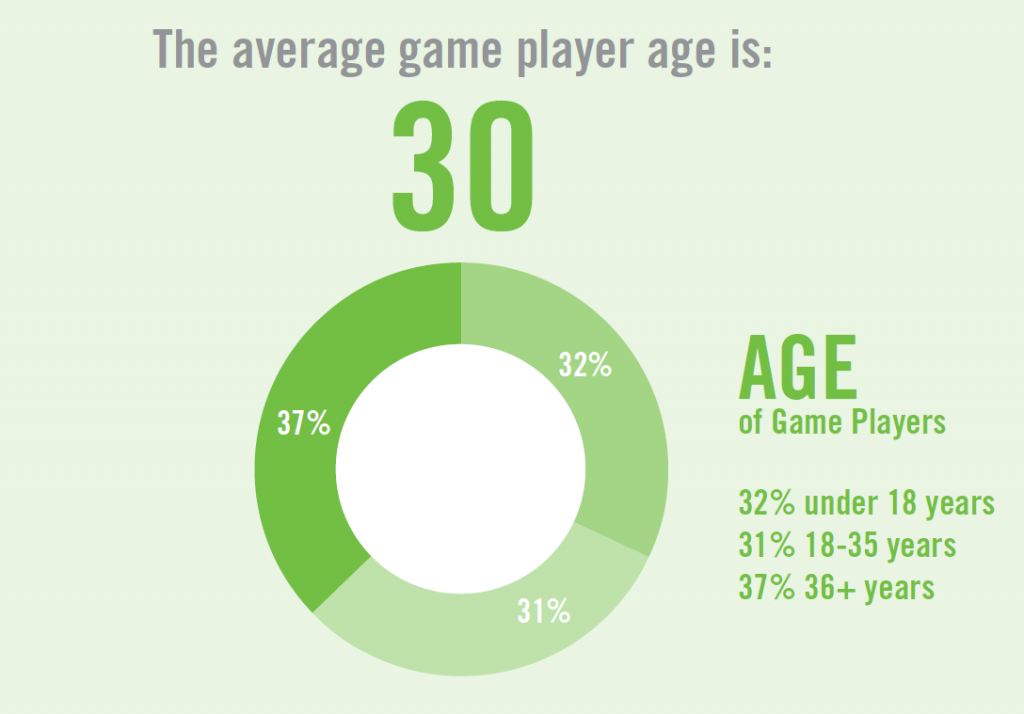
Average Age Data for Gamers in 2012 (Source: Entertainment Software Association).
When looking at the numbers put forth by the ESA since 2004, it becomes pretty obvious that America’s gaming population has been changing. In fact, this year’s findings represent a significant downswing in average age, which had been steadily increasing over the last eight years, reaching a peak of 37 years old in 2011. By the 2011 report, the majority of interactive entertainment consumers were between the ages of 18 and 50, to the point where the demographic categories had to be re-evaluated in order to present more accurate numbers for 2012.
The 2012 study is the largest in scope since the ESA started publishing this report (with about 30% more respondents than in the five years prior). It’s also, overall, the most accurate depiction of the state of the video game consumer in 2012, shedding light on data that has been previously obscured by a smaller sample size.
This year’s study lays to rest the notion that women do not play video games. The prior eight years of reports had shown a fairly consistent 60/40 split between male and female consumers. In 2012, however, it’s 53% male vs. 47% female. True, given that the US population of about three hundred million, that 3% is just enough to be a statistically significant difference, but – for all intents and purposes – it’s an even split.
Let’s go ahead and put another nail in the coffin of the mythical average loudmouthed, hyper-aggressive gamer. When we think of the kinds of players who give everyone else on the Internet all kinds of grief, we think of the favorite whipping boy of politicians and pundits everywhere: the FPS gamer. And yet, when we look at actual game sales over the past eight years, even though first person shooters had their best year ever in 2012, the sales only represented 18.9% of console video game sales, and only 13% of computer game sales.
Even the super-hardcore, highly-coveted MMO market only represented 11% of the games played online. In fact, when looked at as a whole, all traditional “core” games (action, role-play, sports, strategy) represented only a quarter of the games played online. If “core” and massively multiplayer games are taken together, they still only amount to about a third of games being played online. So, then, what exactly are people playing?
It’s all about the casual game: Farmville, Robot Unicorn Attack, Windows Solitaire, Angry Birds, Just Dance, et cetera. The games that the so-called hardcore gamers scoff at are actually coming to represent an ever-growing, ever-more-profitable segment of the interactive entertainment industry. Games are everywhere now, and being played by nearly everyone (about 72% of the US population, per the ESA’s 2011 findings), but not necessarily the ones that gaming pundits would have expected.
But what do all these numbers actually mean? And how can the ESA’s studies be improved to better reflect the actual state of gaming?
Going forward, I think that it’s key for us to reconsider the image that we have of gamers as defenseless innocents or surly teenagers. The truth of the matter is, interactive entertainment has existed in some mass-market form since the 1970s, and it stands to reason that there is a massive audience that has grown from childhood into adulthood and middle age with entertainment software as a constant presence. It’s often difficult to see this through the chatter on the echo chamber that is the Internet, but it would behoove us to remember that for every highly vocal, highly opinionated gamer, there’s a quiet handful content to simply play games.

E3 2012, Los Angeles Convention Center. (Source: Engadget)
This being the case, the video game industry as a whole should begin to reconsider its nearly slavish devotion to this extremely vocal minority. Those clamoring for more guns, more violence, and more extreme experiences represent a rapidly shrinking portion of the gaming population. It’s ironic that the industry’s biggest event, the Electronic Entertainment Expo is dedicated to chasing these gamers’ dollars with big-budget spectacle and high-priced action games, while the real money is being made by companies like Zynga and Rovio through micro-transactions and ninety-nine-cent downloads.

Least horrible thing I could find on Fat, Ugly or Slutty.
Furthermore, even within the demographic of the core gamer, we can draw from these numbers the fact that we are grown adults and should know better. From posts on Fat, Ugly or Slutty, to the recent debacle surrounding Feminist Frequency‘s Tropes vs Women Kickstarter, it’s important to remember that, statistically, this is not exclusively (or even primarily) the work of ignorant, sexist, homophobic kids. Based on the ESA’s numbers, it’s a fair assumption that a good number of these males behaving like complete jackasses in online games are adults with jobs, relationships, families, responsibilities, and social circles that would be aghast at their online escapades. Within the core gamer demographic, the culture needs to change, and the engine of that change must be gamers realizing that they’re grown-ups and that online anonymity is not carte blanche to behave otherwise.
As a personal point of contention with the ESA’s findings, I am curious to know what the racial, socioeconomic, and gender/sexuality breakdown is for consumers of interactive entertainment. While the fact that women represent essentially half of the gaming public could be an impetus for gaming companies to reconsider their traditionally sexist depictions of women in games, it would stand to reason that knowing exactly who consumes interactive entertainment would lead to a more accurate representation of the audience in games, and more diverse, well-rounded experiences in general. For example, we know, based on a 2010 survey by GameSpot and Univision that Latino/Hispanic gamers, while extremely underrepresented in games, are twice as likely as other demographics to buy new games (and 15% less concerned about price). Meanwhile, we know very little about other US racial groups as consumers of interactive media (or popular media in general), thereby preserving the perceived primacy of the White consumer, and enforcing a White stranglehold on video game content and creation. As little as we know about non-White gamers, we know even less about gamers who do not reside on the straight, cis-gendered end of the spectrum. This is especially damaging given the exceptional virulence and pervasiveness of homophobia and transphobia in online gaming environments. The ESA’s surveys are an opportunity to gather a wealth of information about the gaming public, helping change our perception and attitudes, but it could go further. If future studies would take a lens to traditionally disenfranchised game-playing populations, it could help gamers outside the majority realize that they are not alone, inspiring them to demand change.
On the whole, the information that the ESA has shared already provides us with a form of power. Based on these raw numbers, we can safely say that demonizing the outsider in gaming is inaccurate propaganda. We can see, with startling clarity, that the extremely vocal minority that dominates the discourse within the gaming community is just that: very loud and very small. These findings validate the idea that women don’t just have a place in gaming, but are in fact just as much a driving force as men. Finally, as gaming becomes nearly universal and incredibly varied, we can finally put the to rest the notion of hard-core gamer cred.

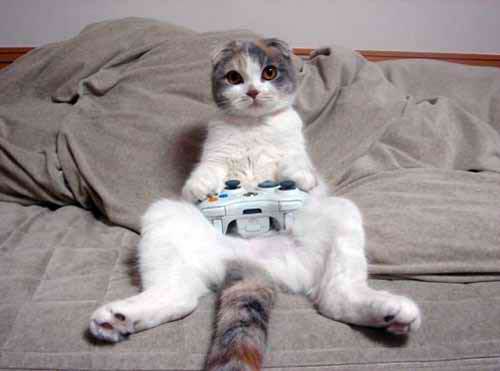
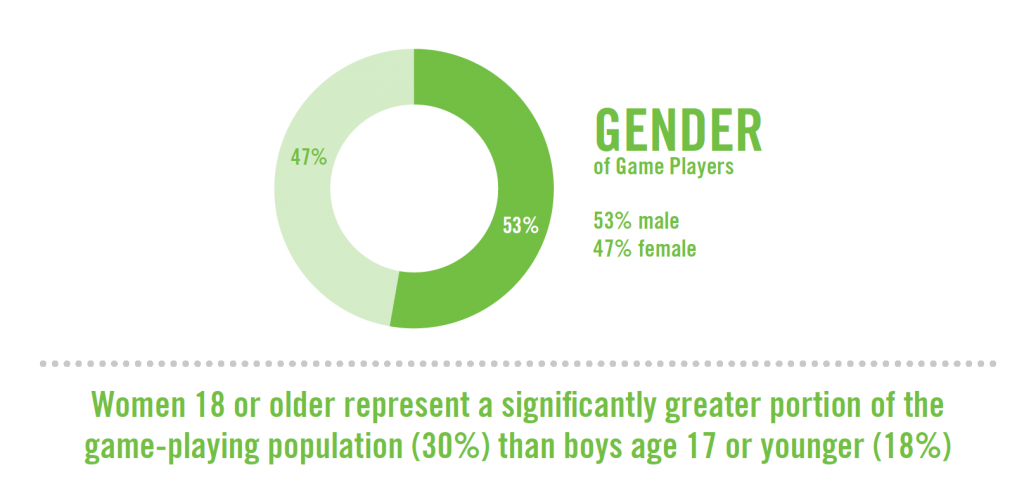
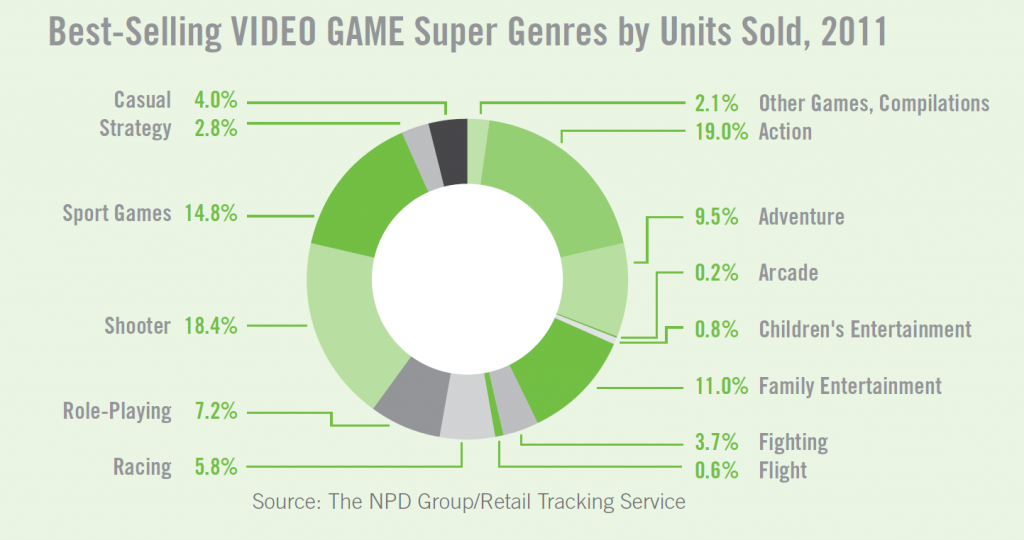
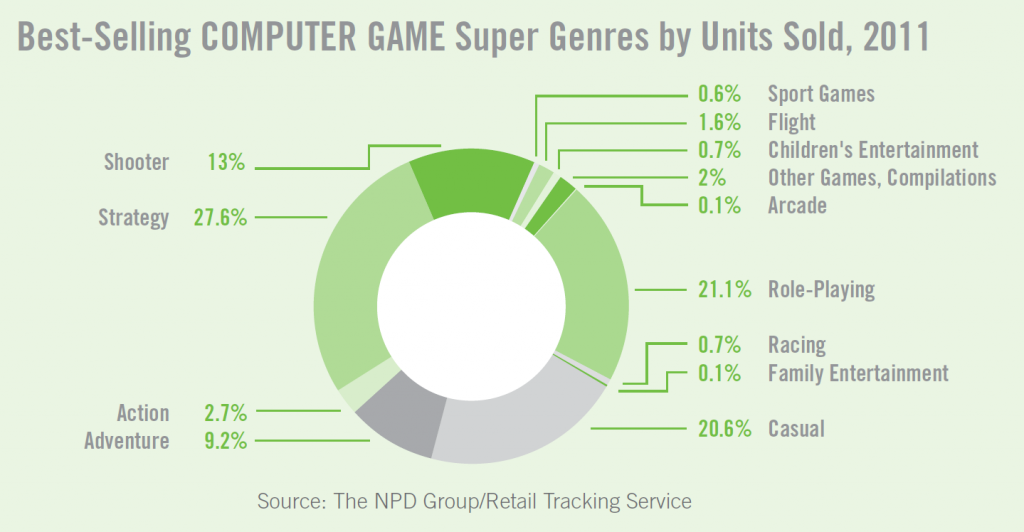

I want to talk about this! Have a dialogue! But all the conversation seems to be happening in Tumblr reblogs (grumble grumble don’t get me started).
First off, awesome job making statistics accessible and framing a good context.
I really want to see more conversations about the notion of cred, and what qualifies a person as a “real” gamer. (Is such a qualification even necessary, and what criteria would we even begin to use?)
In response to comments such as these (http://inspiredapathy.tumblr.com/post/29995761656/arachnofiend-geekquality-the-myth-of-the), if someone actually made it a point to provide their identifying data to be considered in a study, I’d say they have more of an interest in participating in the findings than a person who just happens to play Bejeweled on their phone once in a while out of boredom. So yes, they count. But then, how do we move past this whole need to earn stripes and prove a point when it comes to “cred?”
I wanted to address that. YES, the ESA is counting every responder from their sampling of 2000, and yes, I pointed out that the methodology suffers from the small sample size and the need for more probing questions.
But:
The idea of “cred” is complete and utter, destructive, divisive bullshit. And, frankly, if I have to accept that all the FPS-playing, never finished a game, never even seen a 2D sprite wankers are gamers, then they have to accept that the person who spends twenty hours a week on Farmville is also a gamer. We do not define who is a gamer. Whether the person entertains themselves with interactive media defines whether they’re a gamer.
END. OF. STORY.
This is a lovely response. http://mythicalwashrag.tumblr.com/post/29998574202/arachnofiend-geekquality-the-myth-of-the
PS: Bless the Humble Indie Bundle. Bless it.
Oh oh oh and, I would also like to say that I completely agree with you regarding this:
As little as we know about non-White gamers, we know even less about gamers who do not reside on the straight, cis-gendered end of the spectrum. …. If future studies would take a lens to traditionally disenfranchised game-playing populations, it could help gamers outside the majority realize that they are not alone, inspiring them to demand change.
I want to know what options are made available to people when they are surveyed, whether representing their gender or race. There has to be a way to factor personal data that would fall outside the gender binary, for instance, as a few people on Tumblr have also noted. I wonder if the ESA has a feedback system set up for people to respond to their stats and share their thoughts on what could be improved in the accuracy of data.
“Based on the ESA’s numbers, it’s a fair assumption that a good number of these MALES [emphasis mine] behaving like complete jackasses in online games are adults with jobs, relationships, families, responsibilities, and social circles that would be aghast at their online escapades.” Yet 47% of gamers are female… are none of them supposed to be jackasses? Or are we supposed to believe they’re all playing Farmville and Cooking Mama and the world of aggressive, trash-talking PvP games is alien to them? If we are deconstructing stereotypes and promoting equality, why are we labeling the jackasses as specifically male, and by association from earlier in the article, straight white homophobes?
That is a fair point.
You’re right to argue that we really should avoid generalizations and labeling people, and, to that extent, I’m sorry. That wasn’t my intent.
But if I could offer some support for my generalizations:
First, having been on and subsequently abandoned both X-Box Live and PSN, I can say from personal experience that all of the trash talking that I heard (much of which was about as focused and thought out as a shotgun blast) came from a very narrow demographic.
Second, there were multiple panels at this past year’s geekgirl con that highlighted the outright hostility that women face when playing online (again, from a very narrow demographic) – please check out Fat, Ugly, or Slutty for some examples. The language is very specifically male, and very specifically about intimidating women. You could argue that those are the exception, but given the number of submissions to the site… it’s probably fairly common.
Or we shouldn’t forget that a feminist internet personality suffered a massive online attack this year that spilled into the real world for merely suggesting that gaming might be a little sexist?
Or the well-publicized instance of sexual harrassment at this year’s EVO tournament where a female participant was essentially forced to quit by a member of her own team?
Just about the only evidence I’ve seen of aggressive female gamers is a College Humor video.
Third, insofar as homophobia, I’d like to point out that gay gamers have felt the need to establish safe spaces in order to enjoy their hobby, such as Gaymer Con, LGBT-friendly WoW servers, and the Gaymer subreddit (which, incidentally, got itself nice DDoS attack last month).
Fourth, you can always check out trash talk XBL videos on YouTube. They range from the hilarious to the outright disturbing, are universally male, usually sound really young, and often rely on homophobic slurs, racist epithets and violent, sexualized language.
I’m really not making things up here. Kind of wish I was.
Pingback: Why Do Video Game Covers Matter?
Pingback: Gender in gaming: Tomb Raider #1 | reflections